5 Must-Have Tractor Attachments
- July 11, 2023
- 0 comment
Farmwork is a craft that has been honed over the centuries, yet it is an ever-evolving industry, continually adapting to the rapidly changing world. Modern tractors, far from being the simplistic machines of yesteryear, are now versatile tools of the trade, capable of performing a wide range of tasks with the right attachments. This article explores the top five must-have tractor attachments that are redefining and optimizing farm operations.
Must-Have Tractor Attachments List:
1. Front End Loader
A front-end loader refers to a type of attachment that can be connected to a tractor, typically at the front of the vehicle. It is considered an essential tool in farming operations due to its versatility and wide range of uses.
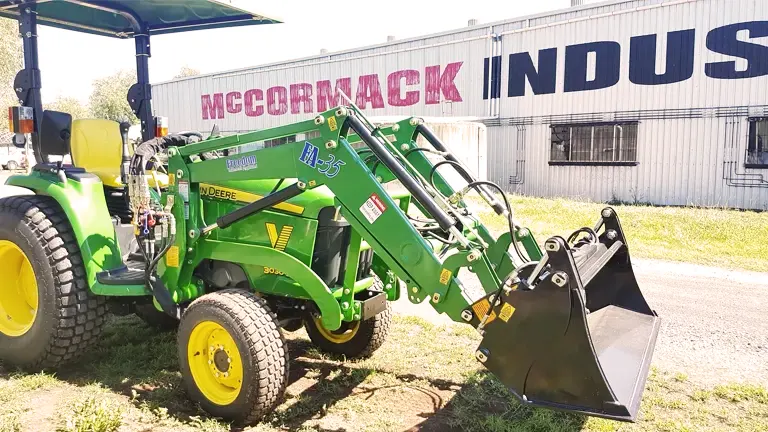
One of the primary functions of a front-end loader is to lift heavy materials. It has a hydraulic lifting mechanism that allows it to raise and lower its attached bucket or other attachments. This capability is particularly useful when moving large amounts of soil, manure, gravel, or feed around the farm. By using the loader, farmers can efficiently transport these materials from one location to another.
Moreover, the front-end loader is designed to carry the lifted materials. It has a spacious bucket or scoop-like attachment that can hold a significant volume of material. This feature enables farmers to load the materials onto trucks, trailers, or other containers easily.
Another advantage of the front-end loader is its dumping capability. Once the materials have been lifted and carried to the desired location, the loader can tilt its bucket or attachment to dump the contents. This is especially useful for spreading soil, distributing feed, or unloading materials in a controlled manner.
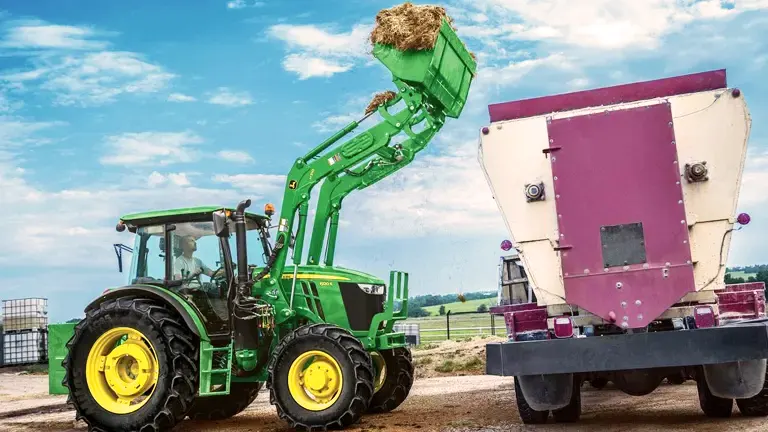
The front-end loader’s versatility is further enhanced by its ability to accommodate various attachments. Some models are equipped with a quick-attach feature, which allows for easy swapping of buckets or other specialized tools. For example, pallet forks can be attached to lift and move palletized goods, while bale spears can be used to handle hay bales. This flexibility makes the front-end loader adaptable to a wide range of farm tasks, reducing the need for multiple dedicated machines.
Overall, the front-end loader is a game-changer in farming operations, significantly improving efficiency and productivity. Its combination of power and precision enables farmers to tackle various tasks with ease, from lifting and carrying heavy materials to precise dumping and specialized handling. By incorporating a front-end loader into their equipment fleet, farmers can streamline their operations and accomplish tasks more effectively.
2. Backhoe
The backhoe attachment is a powerful tool that can be attached to a tractor, typically at the rear end. It is primarily used for excavation and digging tasks on the farm, providing farmers with a versatile and efficient way to handle heavy-duty projects.
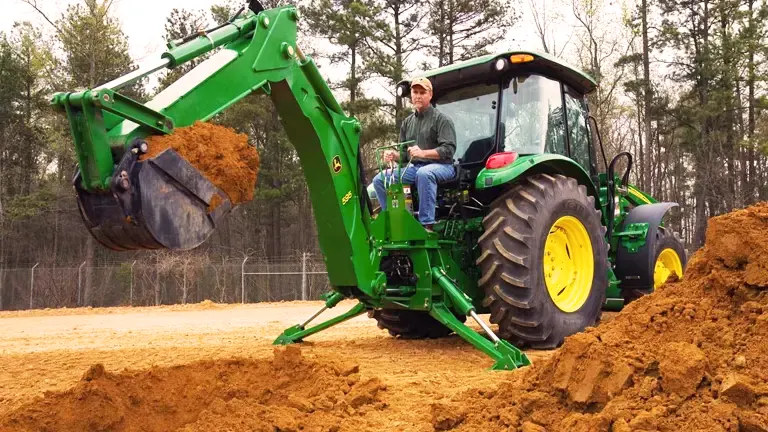
One of the main advantages of a backhoe is its ability to dig trenches. Farmers often need to install irrigation systems or lay underground pipes for various purposes. The backhoe’s digging arm, or boom, equipped with a bucket at the end, can easily cut through soil and create precise trenches of the desired depth and width. This makes it an invaluable tool for improving water management and distribution on the farm.
Another common use for the backhoe is removing tree stumps. When farmers need to clear land for expansion, replanting, or other purposes, the backhoe’s digging capabilities come into play. The powerful arm can dig around the stump, loosen it from the ground, and then lift it out. This eliminates the need for manual labor-intensive stump removal methods and saves considerable time and effort.
Additionally, the backhoe can assist with small-scale construction projects on the farm. It can be used for tasks like digging foundation holes, creating drainage ditches, or preparing the ground for building structures. Its reach and swing arc capabilities allow for precise positioning and digging in tight spaces or hard-to-reach areas. This versatility makes the backhoe a valuable asset when undertaking various construction projects.

Compared to other digging tools, the backhoe offers unique advantages. Its swing arc refers to the rotational movement of the arm, which allows the operator to reach different areas without moving the tractor itself. This makes it easier to navigate around obstacles or work in confined spaces. The reach of the backhoe, combined with its ability to rotate, provides a level of versatility that is unmatched by other digging tools commonly used on the farm.
In summary, the backhoe attachment is an essential tool for farmers when it comes to excavation and heavy-duty tasks. From digging trenches for irrigation to removing tree stumps and assisting with small construction projects, the backhoe offers versatility and efficiency. Its swing arc and reach capabilities make it a valuable investment, allowing farmers to tackle a wide range of projects with ease and precision.
3. Rotary Tiller
The rotary tiller is a valuable attachment for tractors that aids in the process of preparing the land for planting crops. Tilling involves breaking up the soil, loosening it, and creating a favorable environment for seed germination and plant growth. The rotary tiller attachment simplifies this task and offers several benefits for farmers.
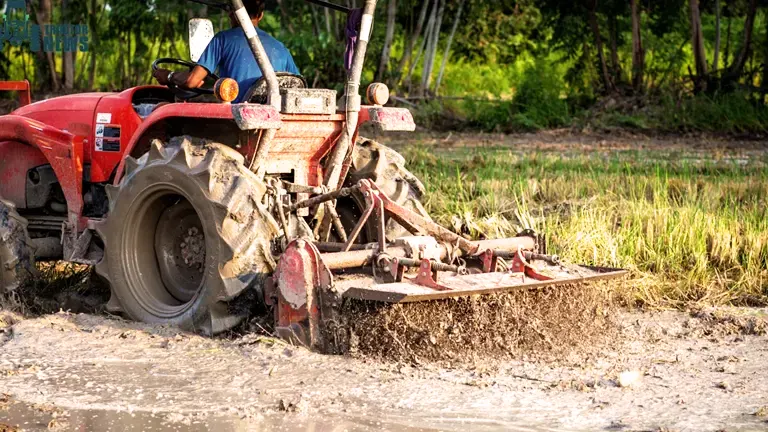
One of the primary functions of a rotary tiller is to break up the soil. It is equipped with a set of rotating blades or tines that penetrate the ground as the tractor moves forward. These blades effectively churn and mix the soil, breaking up compacted clumps and creating a fine, loose texture. By doing so, the rotary tiller improves soil aeration, water infiltration, and nutrient distribution, which are essential for healthy crop development.
The size of the rotary tiller can vary, with different widths available to match the tractor size and the field requirements. This allows farmers to choose the most suitable tiller for their specific needs. For larger fields, wider tillers can cover more ground in less time, while smaller tillers are ideal for narrow rows or tighter spaces.
Newer models of rotary tillers often come with adjustable depth settings. This feature enables farmers to control the depth at which the tiller blades penetrate the soil. Different crops may have specific depth requirements for optimal root development, and the adjustable depth settings allow farmers to customize the tiller’s operation accordingly. This level of control contributes to improved seedbed preparation and ensures that the soil is adequately prepared for successful crop establishment.

Using a rotary tiller offers several advantages over traditional manual tilling methods. It significantly reduces the labor and time required to prepare the land for planting. With the rotary tiller attachment, farmers can cover larger areas quickly and efficiently. It also provides a more consistent and uniform tillage result, ensuring that the entire field receives the same level of soil preparation.
Furthermore, the rotary tiller helps in weed control. By breaking up the soil and burying weed seeds, it disrupts their growth and reduces weed infestation. This reduces the need for herbicides and manual weed removal, contributing to a more sustainable and environmentally friendly farming approach.
In summary, the rotary tiller attachment for tractors simplifies the labor-intensive task of tilling the land for planting crops. It breaks up and aerates the soil, improving its structure and creating an optimal seedbed for crop growth. With adjustable depth settings and various widths available, farmers have more control and flexibility in their soil preparation process. The rotary tiller saves time, labor, and promotes weed control, making it an indispensable tool for efficient and successful farming operations.
4. Boom Sprayer
The boom sprayer is an essential attachment for farmers when it comes to efficiently and uniformly applying pesticides, herbicides, and fertilizers to their crops. It plays a vital role in ensuring the health and productivity of the plants. The boom sprayer attachment offers several advantages for modern farming practices.
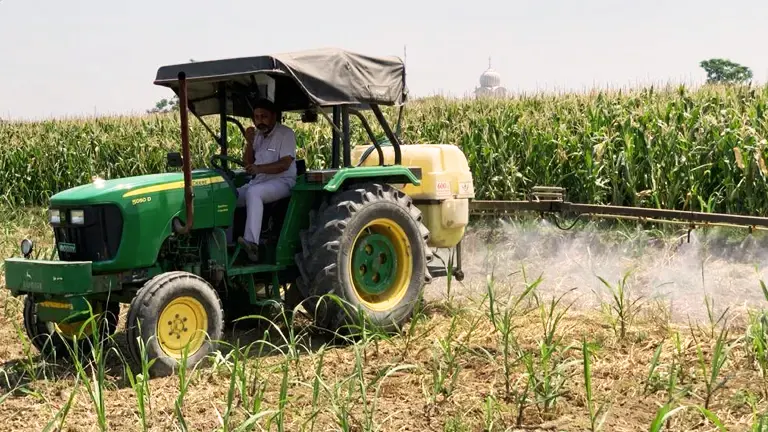
One of the primary benefits of a boom sprayer is its efficiency and uniformity in application. It is equipped with a boom, which is a long bar that extends horizontally from the sprayer and contains multiple spray nozzles. These nozzles release the liquid or chemical solution in a controlled manner, creating a fine mist or spray. The boom can have an impressive width, allowing for the coverage of large areas of land in a shorter amount of time. This efficiency is especially beneficial for farmers with expansive fields or time-sensitive spraying requirements.
The boom sprayer also ensures uniform distribution of the sprayed solution. The arrangement of the spray nozzles along the boom and their calibrated settings enable even coverage across the entire field. This helps to prevent patchy application and ensures that all crops receive the necessary amount of pesticides, herbicides, or fertilizers for effective treatment.
Depending on the model, boom sprayers can have varying capacities to hold the liquid solution. This allows farmers to cover larger areas without frequent refilling, saving time and effort. It also reduces downtime during the spraying process, leading to increased productivity.
In recent years, boom sprayers have incorporated advanced technologies to further enhance their functionality. GPS technology integration is one such advancement. It enables precise tracking and mapping of the field, ensuring accurate coverage and eliminating overlapping or missed areas. This technology can also facilitate variable rate application, where the sprayer adjusts the rate of liquid application based on the specific needs of different areas of the field. By optimizing the use of inputs, such as pesticides or fertilizers, variable rate application reduces waste and promotes more efficient resource utilization.

The integration of GPS technology and other advancements in boom sprayers contributes to precision farming practices. Precision farming aims to maximize yields, minimize environmental impact, and optimize resource usage. By using boom sprayers with advanced features, farmers can make informed decisions and apply treatments precisely where and when they are needed, leading to improved crop health and reduced chemical usage.
In summary, the boom sprayer attachment is a vital tool for modern farmers in maintaining the health and productivity of their crops. Its efficient and uniform application of pesticides, herbicides, and fertilizers saves time and ensures consistent coverage across the field. Integration of GPS technology and variable rate application capabilities further enhance the precision and efficiency of boom sprayers, reducing waste and optimizing input use. With these advancements, boom sprayers play a crucial role in implementing sustainable and effective farming practices.
5. Landscape Rake
The landscape rake is a versatile attachment that serves multiple purposes in ground preparation and maintenance. While its primary function is to clear fields of stones, sticks, and debris, it offers several additional benefits that make it a valuable tool for farmers.
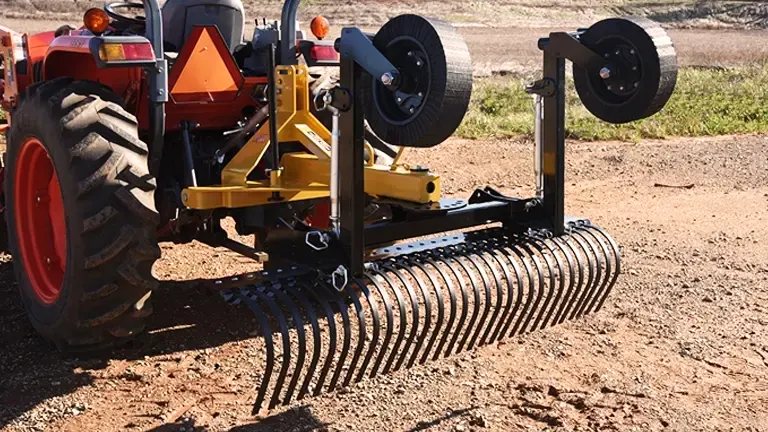
One of the key uses of a landscape rake is in clearing fields. It effectively collects and removes larger debris such as rocks, branches, and other objects that can hinder farming operations. By clearing the field, farmers can create a safer and more productive environment for planting, cultivation, and harvesting activities.
Beyond debris removal, the landscape rake can also assist in leveling the soil. Uneven surfaces can pose challenges for planting and machinery operation. The landscape rake’s sturdy tines or teeth, usually made of durable steel, are designed to break up clumps and redistribute soil, resulting in a more level and uniform ground. This promotes better water drainage, root development, and overall crop health.
Another use of the landscape rake is in spreading topsoil or gravel. It can evenly distribute these materials across a desired area, providing a consistent and uniform surface for planting or construction purposes. By ensuring an even distribution, the landscape rake helps optimize the use of topsoil or gravel, reducing waste and minimizing the need for manual spreading.
In addition to ground preparation, the landscape rake can be used in the initial steps of creating pathways or setting up turf. By raking and leveling the soil, it prepares the groundwork for laying down pavers, stones, or other materials for pathways. It can also help spread and level soil for turf installation, ensuring a smooth and even surface for healthy grass growth.

The simplicity yet effectiveness of the landscape rake highlights the philosophy of modern farming: achieving more with less. By using a single attachment, farmers can perform multiple tasks, reducing the need for separate specialized tools and saving time and resources. The landscape rake’s versatility and efficiency contribute to streamlining farming operations and improving overall productivity.
In summary, the landscape rake attachment is a valuable tool for farmers in ground preparation and maintenance. Its primary function of clearing fields of debris extends to leveling the soil, spreading topsoil or gravel, and aiding in the initial steps of creating pathways or setting up turf. Its simplicity and effectiveness align with the modern farming approach of achieving more with less, reducing the need for multiple tools, and optimizing productivity.
How to Choose a Tractor Attachment
Choosing the right tractor attachment can feel like a daunting task, given the myriad of options available. It is akin to finding the right key to unlock your farm’s potential. When selecting an attachment, there are a few factors you should consider:
- Type of Work: The first consideration should always be the nature of the tasks you need to perform. For heavy lifting and moving, a Front End Loader might be the best fit. For digging and excavation tasks, a Backhoe could be your go-to. Each attachment is designed for a specific purpose, so understanding your needs is paramount.
- Size of Your Tractor: The size and horsepower of your tractor determine the scale of the attachment it can handle. You wouldn’t pair a compact tractor with a heavy-duty backhoe, nor would you saddle a large tractor with a small rotary tiller. Make sure the attachment is compatible with your tractor to ensure optimum performance.
- Budget: While tractor attachments can significantly boost productivity, they can also be a substantial investment. Balance your need for efficiency with your financial capacity. Remember, sometimes, investing in high-quality, durable attachments can save you money in the long run by minimizing maintenance costs and extending the equipment’s lifespan.
Safety Measures
Safety should never be an afterthought when dealing with tractor attachments. They are powerful tools, and misusing them can lead to accidents. Always follow the manufacturer’s instructions to the letter. Wear appropriate safety gear, such as safety glasses, gloves, and steel-toed boots, while operating these attachments. Finally, never exceed the recommended capacity of your attachments; they are designed to function safely within specific limits.
Maintenance and Care
Your tractor attachments are only as good as the care you give them. Regular maintenance is crucial to keep them functioning optimally and to prolong their service life. This care includes regular cleaning after use, appropriate lubrication of moving parts, and frequent inspection for signs of wear or damage. Remember, preventative maintenance is always more cost-effective than repairs.
Conclusion
Tractor attachments transform ordinary tractors into essential tools for farming, greatly expanding their functionality and efficiency. Selecting the right attachments not only boosts productivity and satisfaction but also ensures safety and longevity of your equipment. As essential partners in agriculture, these attachments support your tractor from dawn to dusk, enhancing every task. Together, they orchestrate the rhythm of agricultural success, maintaining a steady tempo of productivity through all seasons.
Frequently Asked Question
- What are the most essential tractor attachments for a small farm? Most small farms find great utility in attachments like the Front End Loader for moving materials, a Rotary Tiller for preparing soil, and a Landscape Rake for general ground maintenance.
- How do I know if an attachment will fit my tractor? Check the specifications of the attachment, which should mention the range of tractor sizes and horsepower ratings it is compatible with. If in doubt, consult with the manufacturer or a professional dealer.
- Can I use attachments from different manufacturers on my tractor? Many attachments use a standard three-point hitch system, making them cross-compatible across different tractor brands. However, always check the specific requirements of each attachment before purchasing.
- Is there a maximum number of attachments I can use on my tractor? The number of attachments you can use simultaneously depends on the size and capability of your tractor, particularly the number of hydraulic outlets it has.
- Do tractor attachments require regular maintenance? Yes, to ensure longevity and optimal performance, tractor attachments require regular cleaning, lubrication, and inspection for signs of wear and tear.
- Are there safety considerations when using tractor attachments? Absolutely, always follow manufacturer guidelines and use the appropriate safety gear when operating tractor attachments. It’s crucial not to exceed the recommended capacity of your attachments.
- Can I use my tractor attachments year-round? While many attachments can be used year-round, some are more seasonal, such as snow blowers or certain types of tillers. Proper storage and maintenance of attachments when not in use are crucial.
- How do I store my tractor attachments when they’re not in use? Attachments should be stored in a dry, sheltered place to protect them from the elements. It’s also recommended to clean and lubricate them before storing them.
- Can I install and remove tractor attachments myself? Many tractor attachments are designed for easy installation and removal. However, always refer to the manufacturer’s instructions, and if you’re unsure, don’t hesitate to ask for professional help.
- Is it more cost-effective to rent or buy tractor attachments? This depends on how frequently you’ll use the attachment. If it’s something you’ll use regularly, it might be more cost-effective to invest in purchasing the attachment. If it’s for a one-off or infrequent task, renting might be a better option.
We highly value your expertise! Kindly share your indispensable insights and thoughts on the must-have tractor attachments in the comments section below. Your personal experiences can be a guiding light for others seeking to make informed decisions when selecting essential attachments for their tractors. Your input is greatly appreciated!

David Murray
Forestry AuthorI'm David Murry, a forestry equipment specialist with a focus on chainsaw operation. With over 13 years of experience, I've honed my skills in operating and maintaining a wide range of machinery, from chainsaws to log splitters. My passion for the outdoors and commitment to sustainable forestry drive my work, which emphasizes safety, efficiency, and staying updated with industry advancements. Additionally, I'm dedicated to sharing my expertise and promoting environmental awareness within the forestry community.










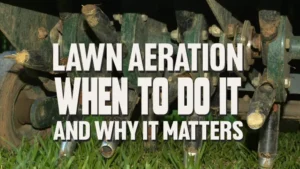


Leave your comment